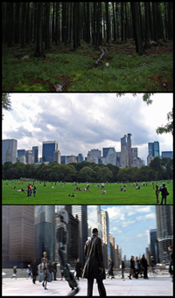
WHERE NATURAL IS ARTIFICIAL;
(controlled and regulated nature)
In Blade Runner, as in many of the films, we see an enhanced correlation between technology and everyday life. Blade Runner depicts a despairing sort of urban jungle in which the density is propagated through advertisements. It would almost seem that one might find comfort in this bleak landscape within the familiar images portrayed through signage, branding, and corporate logos.
Similar feelings are given while watching I, Robot. It is easy to find comfort in the familiarity of objects and dwelling spaces that quite closely resemble our own. It is only in the details that we start to glimpse the uncanny aspects of these environments. The vision of Chicago, 2035 is clean and filled with light, and looks to be the ideal visionary future. But homes without a single potted plant, and streetscapes without any dotting of young trees, lead directly to a feeling of the uncanny. The sense of it is at the highest upon examining this environment and finding it a wholly believable offset of our own, or the Chicago of today.


